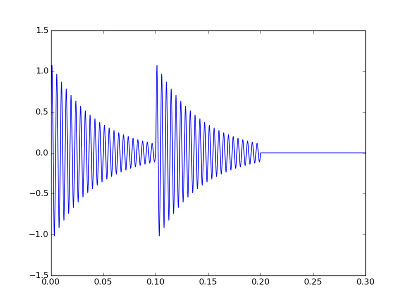Euclidean Rhythms
A python script to derive and play Euclidean rhythms as described in The Distance Geometry of Music by E. D. Demaine et. al. (2007). Packages PyGame and NumPy are required. (For Raspberry Pi users, these come pre-installed on current versions of Raspbian.) Earbuds or speakers are also needed of course.
According to the reference, at least 41 rhythms from world music can be generated by a simple algorithm which resembles the Euclidean Algorithm for finding the greatest common divisor of two natural numbers.
The 41 rhythms given in the reference are contained in a dictionary called playlist. To access and play the conga rhythm:
>>> from euclidean_rhythms import *
>>> playlist['conga']
[1, 1, 0]
>>> play(playlist['conga'])
The "conga" rhythm consists of two beats and a rest as indicated by [1, 1, 0]. The sound wave produced by play is pictured below.
A Euclidean rhythm is determined by a number of beats and a total length (beats plus rests.) For instance the "conga" rhythm above has 2 beats and a total length of 3. Euclidean rhythms are precisely those generated by an algorithm shown below as E.
>>> E(2,3)
[1, 1, 0]
The algorithm, E, is know as Bjorklund's algorithm after its originator. Details can be found in the reference or the source code here.
Musical rhythms tend to be characterized by two qualitative properties termed evenness and deepness. Evenness refers to how evenly spaced the beats are. Clearly, unless the number of beats evenly divides the length of a pattern, beats cannot be precisely evenly spaced. A measure of evenness given in the reference is implemented here as function evenness(pattern). Deepness concerns the distribution of pairwise distances between beats. The reference gives two definitions of deepness which are implemented here as erdos_deep(pattern) and winograd_deep(pattern). These functions return True or False according to whether the respective deepness criteria are met.
Demaine et. al. show that all Euclidean rhythms are as even as possible (i.e., maximize evenness) and with a minor exception all Euclidean rhythms are Erdos deep.
